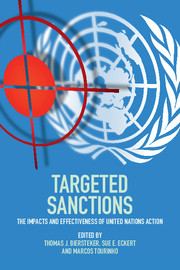Book contents
- Frontmatter
- Contents
- List of figures
- List of tables
- List of contributors
- List of abbreviations
- Introduction
- 1 Thinking about United Nations targeted sanctions
- 2 The purposes of targeted sanctions
- 3 Security Council dynamics and sanctions design
- 4 United Nations targeted sanctions and other policy tools: diplomacy, legal, use of force
- 5 The relationship between United Nations sanctions and regional sanctions regimes
- 6 Coordination of United Nations sanctions with other actors and instruments
- 7 Implementation of United Nations targeted sanctions
- 8 The impacts of United Nations targeted sanctions
- 9 The unintended consequences of United Nations targeted sanctions
- 10 The effectiveness of United Nations targeted sanctions
- 11 Institutional learning in targeting sanctions
- 12 Conclusion
- Appendix 1 List of cases and episodes
- Appendix 2 Sanctions effectiveness
- Appendix 3 TSC database codebook
- Appendix 4 Targeted Sanctions Consortium (TSC) participants
- Bibliography
- Index
12 - Conclusion
Published online by Cambridge University Press: 05 March 2016
- Frontmatter
- Contents
- List of figures
- List of tables
- List of contributors
- List of abbreviations
- Introduction
- 1 Thinking about United Nations targeted sanctions
- 2 The purposes of targeted sanctions
- 3 Security Council dynamics and sanctions design
- 4 United Nations targeted sanctions and other policy tools: diplomacy, legal, use of force
- 5 The relationship between United Nations sanctions and regional sanctions regimes
- 6 Coordination of United Nations sanctions with other actors and instruments
- 7 Implementation of United Nations targeted sanctions
- 8 The impacts of United Nations targeted sanctions
- 9 The unintended consequences of United Nations targeted sanctions
- 10 The effectiveness of United Nations targeted sanctions
- 11 Institutional learning in targeting sanctions
- 12 Conclusion
- Appendix 1 List of cases and episodes
- Appendix 2 Sanctions effectiveness
- Appendix 3 TSC database codebook
- Appendix 4 Targeted Sanctions Consortium (TSC) participants
- Bibliography
- Index
Summary
UN targeted sanctions, our subject of analysis, is a moving target. Throughout the five-year period of this research project, five new country case regimes and eleven new episodes were added to existing regimes, based on actions taken by the UN Security Council. Beyond the sheer number of cases, however, UN targeted sanctions as a policy tool and an instrument of global governance have changed in significant ways over the past quarter century. The instrument has been used for a growing variety of threats to international peace and security, beyond its initial focus on armed conflict and terrorism. The Security Council has subsequently added nuclear proliferation, non-constitutional changes of government, support for R2P, international criminal justice, and the maintenance of peacebuilding processes to its list of objectives in the use of sanctions.
Through these twenty-five years, new types of targeted sanctions have been developed. Since the early 1990s, when the Council relied most heavily on arms embargoes, broad trade restrictions, and occasionally on comprehensive sanctions, it has now refined its use of sanctions to focus largely on the targeting of individuals and entities, as well as on the specific economic sectors that support proscribed activities (often minerals or commodities). Relatively non-discriminating measures such as aviation bans and oil embargoes on an entire country have not been imposed by the UN since 1998. Arms embargoes continue to be utilized regularly and more frequently than any other type of targeted sanction, in spite of their overall ineffectiveness in constraining the use of violence by the targeted parties when used alone.
In the last two decades, substantial institutional learning by the UN and Member States with regard to sanctions design and implementation has taken place. Sanctions resolutions now routinely require the creation of a sanctions committee, committee guidelines, clearly articulated designations criteria, Member State reporting, the formation of Panels of Experts to monitor implementation, and most recently, articulated enforcement authorities. The UN Security Council has become more precise in its resolution language, with greater clarity in the resolution structure, more standardized use of terms, and greater detail in describing target groups and identifying information for individuals designated. Particularly in the non-proliferation cases, an enhanced focus on enforcement through the provisions authorizing inspection, seizure, and destruction of goods seized has been developed.
- Type
- Chapter
- Information
- Targeted SanctionsThe Impacts and Effectiveness of United Nations Action, pp. 265 - 279Publisher: Cambridge University PressPrint publication year: 2016



